When temperatures still hover around 30 degrees Celsius at sunset, lethargy sets in. The Japanese call this listless state “natsubate,” and for centuries, eating unagi (eel) has been considered the culinary cure.
The first mention of beating the heat by eating eel, was in the “Manyoshu,” an eighth-century collection of poems. At that time, unagi was seasoned with either salt or miso, but late in the Edo Period (1603-1868), what is now commonly referred to as koikuchi shōyu (dark-colored soy sauce) began to be produced in modern-day Chiba Prefecture on the outskirts of Edo (now Tokyo). This Edo-style shoyu was used to make glazes, and it was especially good for glazing fish, including eel. The current custom of eating soy-glazed eel, specifically on Doyo no Ushi no Hi (Midsummer Day of the Ox), can be traced back to the late Edo Period.
Then, as today, restaurants would ask famous customers to write a few words of praise that the shop could publicly display. Hiraga Gennai (1726-79), a playwright, natural scientist and Edison-like inventor (in Japan, he is credited with creating a hand-operated generator and a thermometer), wrote that eating a restaurant’s excellent eel that particular day (which just happened to be Doyo no Ushi No Hi) had restored his waning energy.

